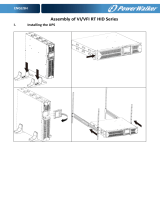
www.powerware.com/ibm +44 (0) 845 177 3410
5
Frequently Asked Questions
1. What happens if the UPS is overloaded? For example, if the
protected equipment and/or load draws more current than
the UPS can provide.
The UPS transfers the load to bypass (for a few minutes) until the
overload condition is reversed. If the overload condition
continues, the UPS automatically shuts down.
2. What causes a UPS to be overloaded?
There are two possible answers: (1) the UPS was undersized
(e.g. the load is rated at 1200 VA but a 1000 VA UPS was
provided), or (2) the customer plugs more equipment into the UPS
than it was designed to handle.
3. How do you convert watts to VA?
Multiply watts by the power factor 1.3.1000W = 1300 VA
4. How do you convert amps to VA?
Multiply amps by voltage (230 volts in Europe). 10A x 230V =
2300 VA
5. How long does it take for the UPS batteries to recharge?
On average it takes 10 times the discharge time for the UPS
batteries to recover. (A 30-minute battery discharge requires
about 300 minutes to recharge.) After each power outage, the
recharge process begins immediately. It is important to note that
the load is fully protected while the batteries are recharging.
However, if the batteries are needed during the recharge time, the
holdover time available will be less than it would have been if the
batteries were fully charged.
6. Where can I get technical help?
Contact your territory representative, call the IBM
®
UPS Hotline at
+44 (0) 845 177 3410, or visit powerware.com/ibm.
7. What is the average lifespan of the batteries used in the
UPS?
The typical life of batteries in a Powerware UPS with ABM
®
technology is 4 to 6 years. Overall service life depends on a
number of factors, including temperature and the number of
battery discharges.
8. Does the UPS need to have a load on it to charge its
batteries?
The UPS should have a minimum of 10% load for UPS to charge
its batteries. Once connected to a standard supply of electricity
(via input plug or hardwiring), your UPS should charge its
batteries regardless of how much load, if any, is attached to it.
9. If my UPS is in storage, how often should I charge the
batteries?
If a UPS is in storage, we recommend that you plug it in every 6
months to prevent the batteries from becoming fully discharged
and significantly shortening their service life. We recommend that
you follow the same guidelines for charging external batteries.
10. I came across a spare, unused Powerware UPS that we had
in storage. Is it still operable?
If the UPS has been in storage for more than 6 months, the
batteries inside your UPS may be bad. If your UPS has been in
storage without any charge for longer than a year, it’s likely that
the batteries need to be replaced.
11. How can you be sure UPS batteries are in good condition in
order to insure they have maximum holdover in the event of
a power failure? What preventive maintenance procedures
should be done and how often should they be done?
The batteries used in the UPS and associated battery modules
and cabinets are sealed, lead-acid batteries often referred to as
maintenance-free batteries. While this type of is sealed and you
do not need to check the fluid level in the battery, they do require
some attention to assure proper operation. You should inspect the
UPS a minimum of once per year by initiating a self-test of the
UPS.
12. I already have surge protection. Why do I need a UPS?
Surge protection will not keep your business and phones
operational during a blackout. In addition, surge protectors do
nothing to improve the quality of power feeding your sensitive and
expensive telecom equipment. The Powerware UPS provides
perfect, clean power to your equipment at all times. Over time,
poor quality power will degrade your equipment.
13. What’s the difference between a surge protector and a UPS?
A surge protector provides just that—surge protection. In addition
to surge protection, a UPS continually regulates incoming voltage
and provides battery backup in the event of a power failure. You’ll
often see surge protectors plugged into a UPS for added surge
protection and additional output receptacles.
14. We have heard that UPS models greater than 750 VA cannot
be installed behind larger UPS models. Is this true?
No. If you are connecting a UPS to a source other than directly to
the utility, the source (such as another UPS or generator) must be
3 to 5 times larger than the smaller UPS.
15. How much capacity of a UPS should I use?
To allow for future expansion, we recommend that you install a
UPS at approximately 75% capacity. In addition, the batteries
degrade overtime so by over sizing you provide room for error. In
the powerware.com/ibm sizing tool we have included a “capacity
used” column.
16. How is battery runtime impacted if I reduce the load on the
UPS?
There can be a significant increase in runtime. Generally
speaking, a UPS that provides 5 minutes at full load will provide
15 minutes at half load.
17. Why is power quality such a problem today?
Today’s high-tech IT equipment and control units are much more
sensitive to electrical disturbances and are more important to the
critical functions of many businesses than in the past. As a result,
power quality problems today are more frequent and more costly
than ever.
18. Are power quality problems always noticeable?
No. In many cases, disturbances can cause imperceptible
damage to circuits and other components, a major cause of
premature equipment failure and problems like computer lockups.
Many power quality problems go unresolved resulting in lost
revenue and data.






















